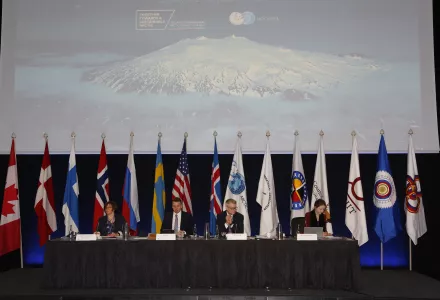
Editor's Note: This brief was originally prepared for and presented at the Harvard/DHS Workshop on Impacts and Policy Challenges from Rapid Climate Change in Alaska, co-hosted by Harvard Kennedy School’s Arctic Initiative and the Science and Technology Directorate of the U.S. Department of Homeland Security on May 8, 2023, in Cambridge, MA. It has been edited from its original form.
Climate change is complex, multi-dimensional, and far-reaching. The impacts of climate change are not uniform, however, and few regions are currently facing the rapid and dramatic effects being experienced in the Arctic. Being a region on the frontlines of climate change with sparse populations and limited infrastructure emphasizes the importance of leveraging opportunities for collaboration and coordination.
The functions of multilateral cooperation in the Arctic related to climate change are multifold, including to:
- Deepen and accelerate understanding,
- Share experiences and lessons learned,
- Mobilize limited resources,
- Coordinate responses, and
- Collaborate on solutions.
Arctic Council
For more than 25 years, the Arctic Council has been the primary multilateral institution dedicated to advancing environmental protection and sustainable development in the region. This unique forum provides an important mechanism to translate research, Indigenous Knowledge, and local experiences into policy advice and guidance at the local, regional, national, and international levels. In addition to the eight Arctic member states (Canada, Denmark, Finland, Iceland, Norway, Sweden, Russia, and the United States), the Council established the unique role of “Permanent Participant,” which provides Arctic Indigenous Peoples with a voice in the decisions and activities of the Council.
At present, the Council also has 38 Observers, including non-Arctic states, intergovernmental and inter-parliamentary organizations, and non-governmental organizations. While military security is not within the mandate of the Arctic Council, the environmental and human security issues emerging because of climate change combined with increased global interest in the region have expanded the range of policy issues on the Council’s agenda and the number and diversity of actors involved in its work.
High-level cooperation through the Council was paused by seven of the Arctic member states in March 2022 as a result of Russia’s invasion of Ukraine; however, some activities at the working level have been able to continue. Norway began its two-year chairship of the Council in May 2023 and is focused on finding opportunities to revitalize more working-level cooperation in the Council’s work.
The benefits of engaging with and contributing to the climate-related work of the Arctic Council can be broken into three main categories:
- Research to understand climate change and inform mitigation. The Council has three working groups that conduct scientific assessments in the Arctic related to climate. The Arctic Monitoring Assessment Programme (AMAP) has a long-term program of work on the impacts of climate change on Arctic ecosystems and peoples. This program aggregates the data and analyses of Arctic states and diverse experts to assess changes at multiple scales (local to regional). This program of work is also supported by the Conservation of Flora and Fauna Working Group (CAFF) that concentrates its efforts on biodiversity and ecosystem impacts and the Protection of Arctic Marine Environment Working Group (PAME) that seeks to improve knowledge of marine ecosystems and their functions. In addition to providing policy advice to its member states, the scientific assessments of these working groups inform multiple international scientific processes, including the Intergovernmental Panel on Climate Change, the Global Biodiversity Assessment, the Global Methane Assessment, and the World Ocean Assessment.
- Risk and emergency management. Climate change presents direct risks to Arctic communities and ecosystems (extreme weather events, coastal erosion, wildfires, fish and wildlife population changes, etc.); sea ice decline also poses indirect risks as a result of increased vessel traffic and interest in the region’s natural resources. The Arctic is a vast, harsh, and fragile environment that is lightly populated with well-known infrastructure deficits. In this context, interjurisdictional coordination and cooperation to support risk and emergency management is critical. The Council’s Emergency Prevention, Preparedness and Response Working Group (EPPR) provides an important mechanism to coordinate safety- and emergency-related services and programs in the Arctic, including support for two regional agreements negotiated under the auspices of the Arctic Council: the Agreement on Cooperation on Aeronautical and Maritime Search and Rescue in the Arctic (2011) and the Agreement on Cooperation on Marine Oil Pollution Preparedness and Response in the Arctic (2023). PAME also plays an important role in this area through its marine safety program of work and its close ties to the International Maritime Organization.
- Adaptation planning and implementation. Arctic communities and ecosystems are experiencing rapid and dramatic effects from climate change. Planning for and implementation of adaptation strategies that are context-specific and led by the communities that live in the Arctic are critical for long-term resilience. The Council’s Sustainable Development Working Group (SDWG) provides a platform for identifying the common climate change-related needs and priorities of Arctic communities, developing capacity, and sharing tools and lessons learned across the Arctic. The Permanent Participants (Arctic Indigenous Peoples Organizations) play a particularly strong role in setting the priorities of the SDWG and contributing to its work. The EPPR and PAME also contribute to relevant risk assessments, understanding infrastructure impacts, and adaptation planning in the region.
North American Arctic Cooperation
While the Arctic as a region shares many commonalities, the environment and communities of the North American Arctic (United States, Canada, Greenland) face a number of challenges with which the Nordic Arctic has little or no experience, including dramatic land degradation due to permafrost thaw, the need to assess immediate and potential community relocations, and significant infrastructure deficits. Furthermore, geographic proximity and like-minded governments make coordination and collaboration on climate change-related policies and programs both practical and feasible. The United States undertakes bilateral cooperation with Canada and Greenland in the Arctic; the impacts of climate-change combined with current geopolitical circumstances that constrain circumpolar cooperation may present an opportunity to establish stronger sub-regional cooperation.
Spence, Jennifer. “Opportunities for Multilateral Cooperation on Climate Change in the Arctic.” Belfer Center for Science and International Affairs, Harvard Kennedy School, August 16, 2023




